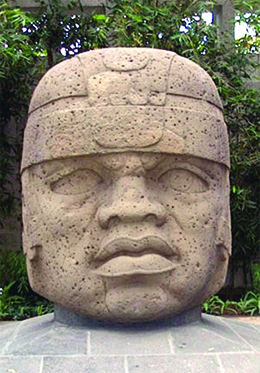| << Chapter < Page | Chapter >> Page > |
Flourishing along the hot Gulf Coast of Mexico from about 1200 to about 400 BCE, the Olmec produced a number of major works of art, architecture, pottery, and sculpture. Most recognizable are their giant head sculptures ( [link] ) and the pyramid in La Venta. The Olmec built aqueducts to transport water into their cities and irrigate their fields. They grew maize, squash, beans, and tomatoes. They also bred small domesticated dogs which, along with fish, provided their protein. Although no one knows what happened to the Olmec after about 400 BCE, in part because the jungle reclaimed many of their cities, their culture was the base upon which the Maya and the Aztec built. It was the Olmec who worshipped a rain god, a maize god, and the feathered serpent so important in the future pantheons of the Aztecs (who called him Quetzalcoatl) and the Maya (to whom he was Kukulkan). The Olmec also developed a system of trade throughout Mesoamerica, giving rise to an elite class.

After the decline of the Olmec, a city rose in the fertile central highlands of Mesoamerica. One of the largest population centers in pre-Columbian America and home to more than 100,000 people at its height in about 500 CE, Teotihuacan was located about thirty miles northeast of modern Mexico City. The ethnicity of this settlement’s inhabitants is debated; some scholars believe it was a multiethnic city. Large-scale agriculture and the resultant abundance of food allowed time for people to develop special trades and skills other than farming. Builders constructed over twenty-two hundred apartment compounds for multiple families, as well as more than a hundred temples. Among these were the Pyramid of the Sun (which is two hundred feet high) and the Pyramid of the Moon (one hundred and fifty feet high). Near the Temple of the Feathered Serpent, graves have been uncovered that suggest humans were sacrificed for religious purposes. The city was also the center for trade, which extended to settlements on Mesoamerica’s Gulf Coast.
The Maya were one Mesoamerican culture that had strong ties to Teotihuacan. The Maya’s architectural and mathematical contributions were significant. Flourishing from roughly 2000 BCE to 900 CE in what is now Mexico, Belize, Honduras, and Guatemala, the Maya perfected the calendar and written language the Olmec had begun. They devised a written mathematical system to record crop yields and the size of the population, and to assist in trade. Surrounded by farms relying on primitive agriculture, they built the city-states of Copan, Tikal, and Chichen Itza along their major trade routes, as well as temples, statues of gods, pyramids, and astronomical observatories ( [link] ). However, because of poor soil and a drought that lasted nearly two centuries, their civilization declined by about 900 CE and they abandoned their large population centers.

Notification Switch
Would you like to follow the 'U.s. history' conversation and receive update notifications?